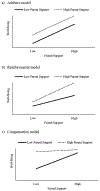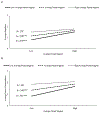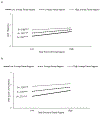The Interplay of Friends and Parents in Adolescents' Daily Lives: Towards A Dynamic View of Social Support
- PMID: 31741574
- PMCID: PMC6860923
- DOI: 10.1111/sode.12363
The Interplay of Friends and Parents in Adolescents' Daily Lives: Towards A Dynamic View of Social Support
Abstract
This daily diary study investigated the interplay of perceived friend and parent support in adolescents' everyday lives. Specifically, we tested the interactive effects of friend and parent support on adolescent well-being at both the intra- and inter-individual level. A diverse sample of 119 adolescents (M age=15.36) completed diary reports for two weeks. Multivariate multilevel models demonstrated that on days adolescents felt more supported by their friends or parents, they experienced increases in their happiness and social connectedness. Additionally, parent support emerged as a protective factor for youth lacking friend support, although patterns differed at the intra- versus inter-individual level. The findings underscore the dynamic nature of social support in adolescents' daily lives and highlight the interactive roles of friends and parents in promoting youth well-being.
Keywords: adolescence; daily diary; friendship; parents; social support.
Figures



Similar articles
-
Intra- and Inter-Individual Differences in Adolescent Depressive Mood: the Role of Relationships with Parents and Friends.J Abnorm Child Psychol. 2018 May;46(4):811-824. doi: 10.1007/s10802-017-0321-6. J Abnorm Child Psychol. 2018. PMID: 28612262 Free PMC article.
-
Contextual moderators of momentary cortisol and negative affect in adolescents' daily lives.J Adolesc Health. 2014 May;54(5):536-42. doi: 10.1016/j.jadohealth.2013.10.007. Epub 2013 Dec 8. J Adolesc Health. 2014. PMID: 24321894
-
Daily Fluctuations in Adolescents' Perceived Friend Dominance and Friendship Clout: Associations with Mood and the Moderating Role of Anxiety.J Youth Adolesc. 2024 Mar;53(3):537-549. doi: 10.1007/s10964-023-01906-3. Epub 2023 Dec 6. J Youth Adolesc. 2024. PMID: 38055132
-
Adolescents' daily face-to-face and computer-mediated communication: Associations with autonomy and closeness to parents and friends.Dev Psychol. 2020 Jan;56(1):153-164. doi: 10.1037/dev0000851. Epub 2019 Oct 31. Dev Psychol. 2020. PMID: 31670551
-
Social support and diabetes management in childhood and adolescence: influence of parents and friends.Curr Diab Rep. 2006 Apr;6(2):117-22. doi: 10.1007/s11892-006-0022-y. Curr Diab Rep. 2006. PMID: 16542622 Review.
Cited by
-
Using Ecological Momentary Assessments to Understand Black Youths' Experiences of Racism, Stress, and Safety.J Res Adolesc. 2022 Mar;32(1):270-289. doi: 10.1111/jora.12733. Epub 2022 Feb 3. J Res Adolesc. 2022. PMID: 35118752 Free PMC article.
-
Factors contributing to adolescents' COVID-19-related loneliness, distress, and worries.Curr Psychol. 2022 Feb 13:1-12. doi: 10.1007/s12144-022-02752-5. Online ahead of print. Curr Psychol. 2022. PMID: 35194361 Free PMC article.
-
Racial discrimination moderates associations between sociopolitical discussions and internalizing problems among racially minoritized college students.Cultur Divers Ethnic Minor Psychol. 2023 Oct;29(4):540-550. doi: 10.1037/cdp0000608. Epub 2023 Jul 10. Cultur Divers Ethnic Minor Psychol. 2023. PMID: 37428755 Free PMC article.
-
Measuring Happiness in Adolescent Samples: A Systematic Review.Children (Basel). 2022 Feb 8;9(2):227. doi: 10.3390/children9020227. Children (Basel). 2022. PMID: 35204948 Free PMC article. Review.
-
Development of the gut microbiota in the first 14 years of life and its relations to internalizing and externalizing difficulties and social anxiety during puberty.Eur Child Adolesc Psychiatry. 2024 Mar;33(3):847-860. doi: 10.1007/s00787-023-02205-9. Epub 2023 Apr 18. Eur Child Adolesc Psychiatry. 2024. PMID: 37071196 Free PMC article.
References
-
- Bagwell CL, & Schmidt ME (2011). Friendships in childhood and adolescence. New York, NY: Guilford Press.
-
- Bokhorst CL, Sumter SR, & Westenberg PM (2010). Social support from parents, friends, classmates, and teachers in children and adolescents aged 9 to 18 years: Who is perceived as most supportive? Social Development, 19, 417–426. 10.1111/j.1467-9507.2009.00540.x - DOI
-
- Brown BB & Bakken JP (2011). Parenting and peer relationships: Reinvigorating research on family-peer linkages in adolescence. Journal of Research on Adolescence, 21, 153–165. 10.1111/j.1532-7795.2010.00720.x - DOI
Grants and funding
LinkOut - more resources
Full Text Sources
